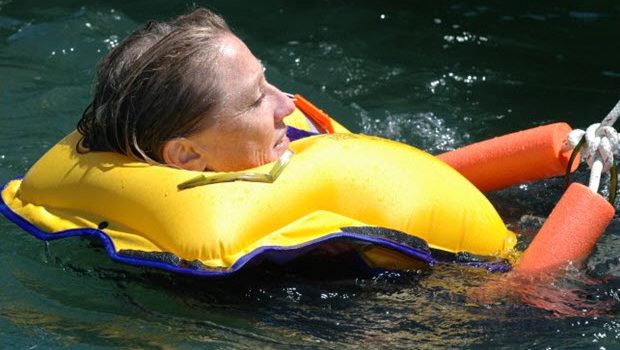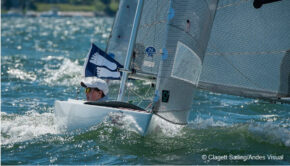Reframing the view on Auto-inflate PFDs
Published on June 14th, 2019
by Darrell Nicholson, Practical Sailor
In the July 2019 issue of Practical Sailor, we dive again into the world of inflatable PFD/harnesses. This time our focus is on auto-inflation systems. The report, written by marine safety expert Ralph Naranjo, highlights the proper care and use of various auto-inflators on the market. It also describes some of the many recent changes in the design of PFDs and harnesses.
The crux of the report, however, is the gradual and potentially dangerous shift in perceptions among offshore sailors with regards to inflatable PFDs.
Based on his study of recent accidents and experience as an instructor at dozens of safety at sea seminars, Naranjo observes that we’ve grown so accustomed to wearing inflatable PFDs that we’ve forgotten their limitations. And Practical Sailor’s editorial staff is not immune to criticism in this regard.
The most telling example of our shifting perspective on inflatable PFDs is the language that we use. Like most marine publications, we refer to inflatable jackets with an auto-inflate feature in shorthand as “automatic inflatable PFDs,” or “auto-inflating PFDs.” In fact, we should regard all of the so-called auto-inflate PFDs on the market as manually inflatable PFDs with an auto-inflate feature.
This is precisely how International Maritime Organization regards them, for good reason. This is more than just a matter of semantics. Expecting too much of your inflatable PFD can delay reactions, and lead to unpreparedness or equipment failures that can be dangerous, even fatal.
A case in point: the sailor who regards their inflatable PFD as dependent primarily on manual inflation (rather than automatic) will pay more attention to the reliable mechanisms involved in manual inflation. This sailor will know precisely how to access and use the manual pull cord to activate the gas-cylinder inflation should the auto-inflate trigger mechanism fail.
Likewise, they will know where to find the oral inflation tube, which is buried beneath layers of cloth in some new designs. Meanwhile, the sailor who was expecting their PFD to magically inflate the moment it hits water will be left fumbling in the dark if the “auto-inflation” doesn’t happen. (The failure to auto-inflate happens more frequently than you would think.)
Among the experts we turned to for this report was Mark Bologna of Landfall Navigation in Stamford, Connecticut. A safety guru and a major supporter of safety training, Bologna has decades worth of experience selecting and servicing inflatable PFD’s. He was quick to confirm that Ralph’s observations were spot-on and that his concerns were legitimate.
Bologna outlined the specific steps sailors should take each season to ensure their PFD remains reliable. And to emphasize his point, he shared several stories of gear that was rendered useless due to misuse, ignorance, or plain neglect by their owners. Fortunately in these anecdotes the disasters were narrowly averted.
As any longtime reader of Practical Sailor knows, we don’t have to look too far to find PFD incidents that didn’t turn out as well. In recent years, we’ve document several incidents in which inflatable PFDs failed to perform as expected and led to tragic results.
The highly publicized crew overboard incident at the start of the 2018 Chicago-Mackinac Race drove home the critical importance of equipment awareness (see Review Committee Report on the Fatal Accident Involving Imedi During the 2018 Chicago Yacht Club Race to Mackinac).
As with many sailing accidents, a variety of factors contributed to the death of Jon Santarelli, a crew member aboard the high-performance racing sloop Imedi. The breeze was up, the TP52 had a mainsail with no reef points, and the crew failed to make contact with Santarelli on three successive passes.
Too much mainsail area and too much boat speed were clearly factors that impeded rescue. But the failure of the PFD worn by the Santarelli was almost surely another contributing factor.
The PFD was an SSM-Barcelone vest with a Hammar MA-1 hydrostatic inflator. The vest was reported to be over 10 years old. It was one of 13 that belonged to the boat’s owner.
Whether the inflator had recently been replaced, or if Santarelli had done any pool training with the jacket is unknown. But what is apparent is that when he went over the side, the auto-inflation feature failed. And for some reason, Santarelli was not able to manually inflate using the pull-cord on the gas cylinder, or by using the oral inflation tube.
The botched post-accident investigation was just as distressing. Santerelli’s body was recovered a week after he went overboard, but for some reason the medical examiner did not retain the life jacket in question for inspection by the US Coast Guard. Instead, it was cremated along with the victim. Important clues regarding what went wrong disappeared in the heat.
But one fact became apparent. During the cremation, heat caused the life jacket’s CO2 cylinder to burst it’s seal outward indicating that the CO2 cylinder still had a charge, the auto inflation mechanism had failed and the manual pull-tab linkage had either never been used or also malfunctioned. The destruction of the life jacket prior to a professional inspection leaves many questions unanswered.
For more on today’s inflatable PFDs harness, and how you should approach the care and use of your gear, see the July 2019 issue of Practical Sailor. Sailors interested in a more comprehensive study of survival gear and man overboard recovery should reference our downloadable ebook MOB Prevention and Recovery, available in our online bookstore.








 We’ll keep your information safe.
We’ll keep your information safe.